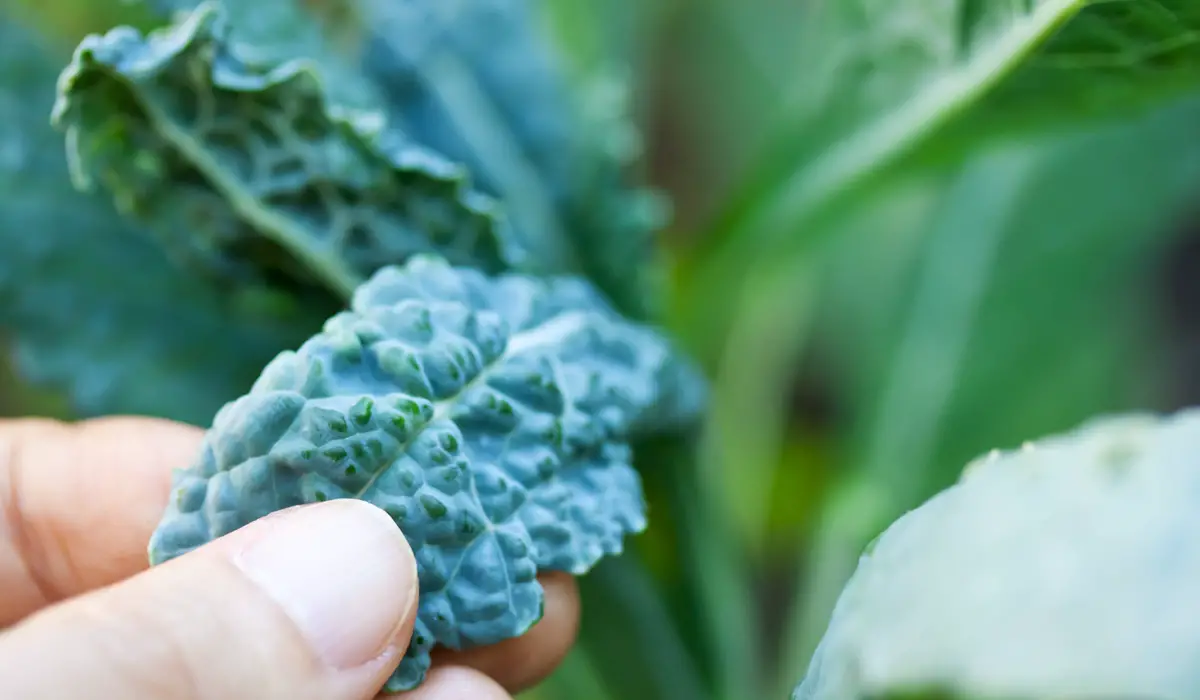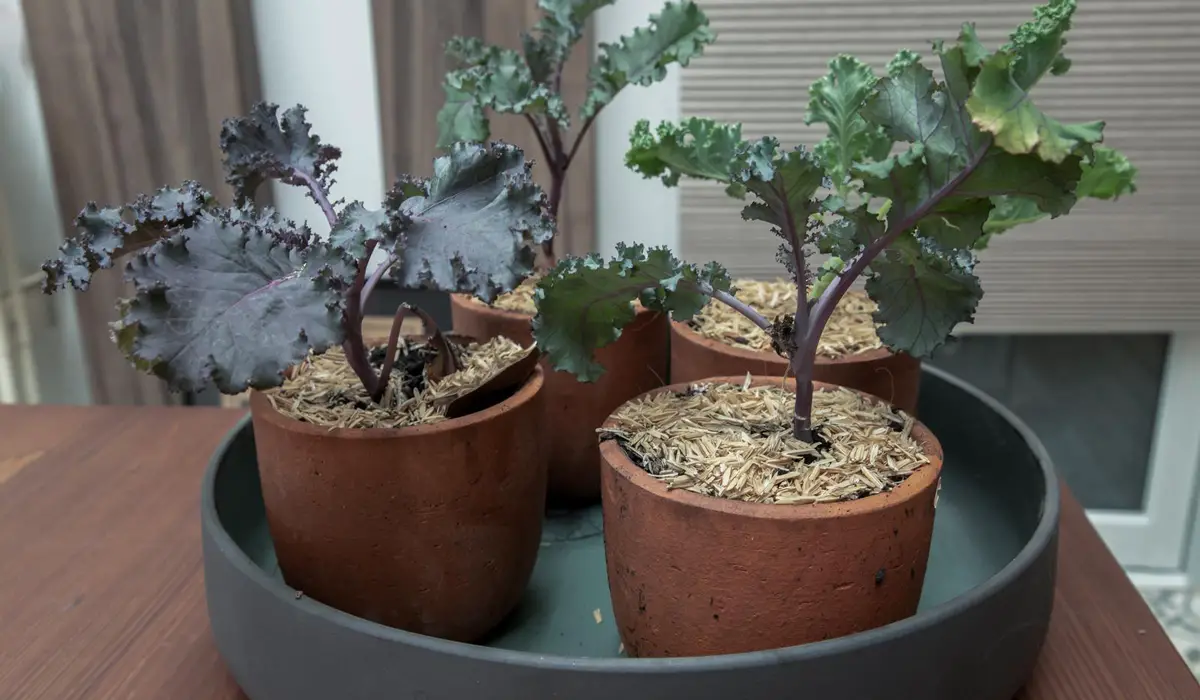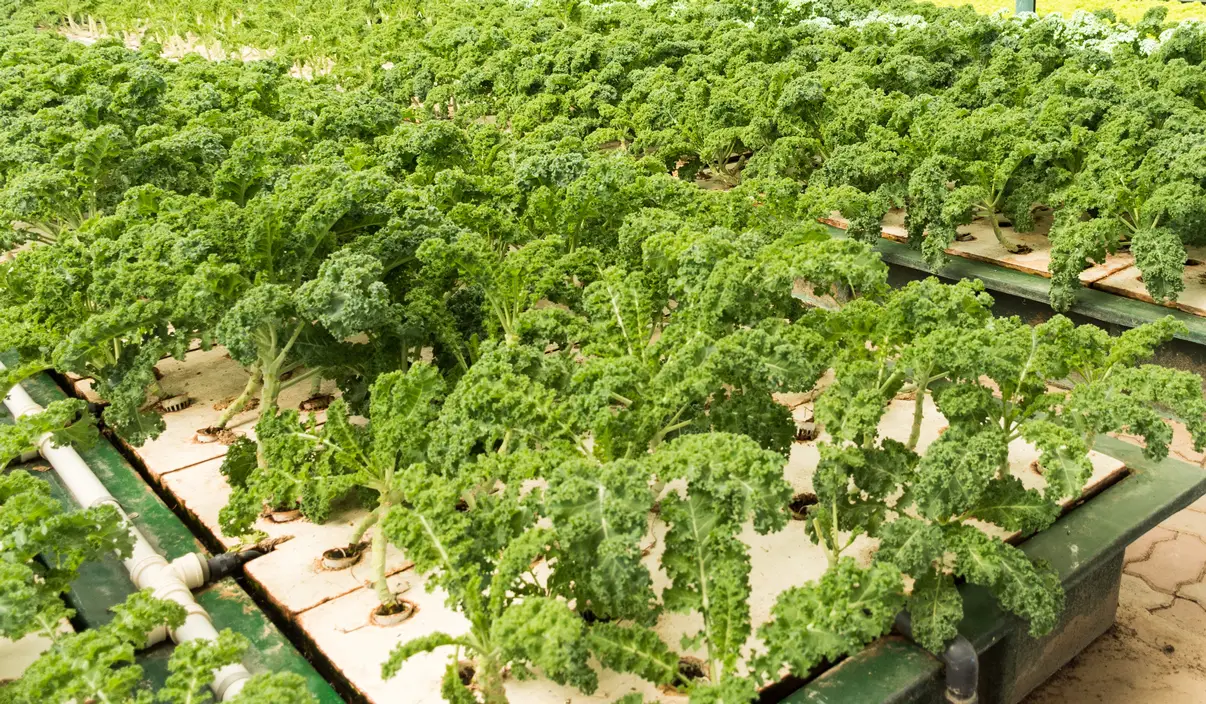How To Grow Hydroponic Kale (A Beginner’s Guide)

This post follows our research editorial guidelines.

Do you want to start growing your own batch of kale hydroponically? If you’re just starting out, this process can be a little intimidating, but the good news is that it’s really quite easy once you get started. I didn’t have a green thumb for years, so if I can do it, you can, too!
Kale is considered an extremely healthy food because it contains a ton of vitamins, making it the perfect addition for both weight loss and maintaining a healthy lifestyle.

Table of Contents
A hydroponics system makes it easy to grow all sorts of kale including curly kale, red kale, winter kale, and ornamental kale — all of which have their own unique set of health benefits.
To get started with growing your own kale, you first need to determine the kind of hydroponic system you want to use. Typically, either a Nutrient Film Technique or Deep Water Culture is best.
Below, we answer all of your commonly asked questions regarding how to grow kale seeds and cuttings hydroponically, as well as how much light and the types of nutrients they need to survive.
Consider this your beginner’s guide to all things kale!
Does Kale Grow Well in Hydroponics?
Kale grows very well in hydroponics. In fact, it is considered one of the best leafy greens to grow with hydroponic methods due to how versatile and adaptable it is to any growing system. Hydroponically grown kale will also be more nutrient dense due to its increased access to nutrients and oxygen.
Plus, there are multiple hydroponic methods recommended for growing kale due to how lightweight it is, such as growing them in a deep water culture or nutrient film technique.
Starting Kale Seeds Hydroponically
There are two methods of growing a new kale plant from scratch. The first method is to use kale seeds.
Generally speaking, this method is recommended when growing hydroponic kale since it nurtures the plant from start to finish.
To get started with kale seeds hydroponically, follow these steps:
1. Germinate Your Kale Seeds
Germination is a form of growth. It occurs when a seed turns into a seedling, which is what will start the formation of roots that the kale plant will need to continue growing.
You can use starter cubes to germinate the seeds, as these will help promote healthy root growth. Add four seeds to your cube to germinate. Just be sure to briefly soak your starter cubes in water first before adding the seeds so they don’t float away!
On average, it should take about a week for your kale seeds to become seedlings. Keep in mind that when you’re first attempting this, you have to be very mindful of the temperature you keep your seeds in.
Kale seeds grow best in temperatures between 59.9 and 75.2 degrees Fahrenheit. Anything cooler than this will slow down growth production.
2. Thin Out the Extra Seedlings
Once the seeds start to grow and develop their first set of true leaves, you’ll have to thin out the extra seedlings. This is why I recommended adding up to four seeds per cube or netting pot, as you’ll ultimately keep the one that looks the best.
To thin out the seedlings, use a pair of sharp scissors to snip off the extra plants at the soil line. Be sure not to pull up the seedlings, as this can damage the roots of your chosen plant.
3. Allow Roots To Develop
Once you pick out the right seedling, you can’t do anything else but wait for its roots to develop. This should only take about three to four weeks. After the roots develop, it’s ready to be transferred to your hydroponic setup.
However, there is one thing you can do while waiting for roots to grow – and that is to either start growing new seeds in your remaining starter cubes or to work on setting up your hydroponic system, as this will be used for the next steps in the process.
4. Transfer to Your Hydroponic Setup
After the 3 to 4 weeks have passed, your seedling should have a few leaves and be about 2” tall. At this point, it’s ready to be transferred to your hydroponic system.
Keep in mind that if you’re planning on having a continuous supply of kale through the use of your hydroponic system that you’ll want to keep this process going about every 3 weeks.
What Kale Varieties Are Best for Growing Hydroponically?

Kale is one of the most popular vegetables to grow hydroponically due to its resistance to pests and diseases, as well as its ability to thrive in a variety of conditions. The best kale varieties for hydroponic growing are those that are both fast-growing and high yielding.
Let’s take a look at a few of the best varieties of kale to grow hydroponically.
Siberian Kale
This plant has deeply-cut, jagged foliage with lengthy juicy stalks which sprout to create thick, robust, petite vegetation reaching between 30-42cm (12-15″) in height.
Red Russian Kale
Red Russian Kale will produce foliage with flat, jagged, grey-green leaves as well as purple stems and veins that become even more vivid following a frost.
Lacinato kale
An extremely attractive heirloom veggie, Lacinato kale (also called dinosaur or Tuscan kale) has long, deep green fronds that fan out from the core stalk like an ostrich’s feathers.
Dwarf green curly kale.
Dwarf Green Curled kale, an heirloom vegetable from Scotland dating back to 1865, was originally called Dwarf Curles. It is a very small plant that reaches up to 12-18″ in height but features tender, juicy foliage with tight curls.
These varieties have thick leaves that can handle the extra moisture from a hydroponic setup, and are also very cold-tolerant, making them ideal for indoor setups. Additionally, these varieties boast excellent flavor and nutrition content, making them an ideal choice for any gardener looking to maximize their yield with hydroponic gardening.
Growing Kale Hydroponically From a Cutting
The second method, although less popular, is to start your kale plant with the cutting of a former, fully grown kale plant. Here’s what you need to do if you choose this method of growing kale:
Harvesting Kale From a Mature Plant
The main difference between growing from seeds and growing from a cutting is how your process begins.
What you need to do is to take an already existing mature kale plant and take your cutting from it. When doing this, you also want to remove all of the leaves from the cutting.
Place the Stem in a Jar of Water
From here, you’re not going to directly move your cutting from the plant into your hydroponic system.
First, you need to place it in a jar of water that is ¾ of the way full for about a week and keep that jar in a sunny place. The stem will start to grow leaves on it after about a week. If you’re looking to experiment with small-scale hydroponic kale try keeping your cutting in the jar and creating a Kratky jar setup. It’s incredibly easy!
Take Note of What’s Growing
As your kale continues to grow inside the jar of water, you should notice a couple of things taking place. First, you’ll notice the leaves growing from the main stem.
Second, you’ll also notice that the secondary stalks are turning yellow and are loosening enough to come off of the main stem. Both of these are good signs that your kale is growing as it should.
Roots Growing and Transplanting
After 2 weeks, you should see roots growing off of your kale stem. This is now the perfect time to transplant them into your hydroponic system.
This is a process that you can repeat with either your own kale that you’ve grown or even with store-bought kale.
How Much Light Does Hydroponic Kale need?
Kale likes full light – between 6 and 10 hours of exposure per day. However, depending on the space you have available, that may not always be feasible. As such, you can use fluorescent lights as well to make them more adaptable for you.
As long as kale is exposed to either fluorescent or full, natural light for 6 to 10 hours a day, it should grow without issue.
Water/Best pH for Hydroponic Kale

Because hydroponic systems eliminate the need for you to routinely water your kale crops, you should instead pay close attention to the temperature of the water it’s growing in.
Kale needs the right water temperature to grow. Generally speaking, this is between 65 and 70 degrees Fahrenheit. You can measure the temperature of the water by investing in a regular thermometer and submerging it beneath the surface of the water for a few minutes.
Likewise, you should also ensure that the water has the proper pH level. A pH measurement is a test of how acidic/base the water is. The more acidic it is, the more difficult it’ll be for kale and other crops to grow.
In the context of growing plants, such as kale, the pH level in water is used to determine how much hydrogen ions or hydroxyl ions it has. This ultimately determines how easy it is for things to be dissolved in the water – aka the nutrients your kale needs to survive.
With a range from 0 to 14 with the higher range being the highest level of acidity, you want to make sure your water has a pH of 6.0. This can be a little higher or a little lower, but as long as you’re around the 6.0 range, you should be good.
The Best Hydroponic System For Growing Kale
The best hydroponic growing system for kale is either a Nutrient Film Technique (NFT) or Deep Water Culture (DWC).
A NFT is a popular hydroponic system in which a pump is used to transport water and nutrients to a growth tray before getting recycled. With this type of hydroponic system, the roots are constantly getting water.
This system is usually best for plants that are lightweight and, as such, don’t require a ton of support – like kale.
A deep water culture system, on the other hand, is a type of hydroponic system in which the plant’s roots are submerged in nutrient-rich water, so it’s constantly getting an influx of water, nutrients, and oxygen.
DWCs are traditionally the most common and easy-to-use hydroponic systems, so if you’re just starting out with kale, this is the recommended system you use.
The reason why this method is recommended for growing kale is that it tends to make little changes to the water temperature and pH level, yielding a more successful crop.
Nutrient Solutions For Hydroponic Kale
Kale requires a nitrogen rich fertilizer in order to grow successfully.
But how can you make sure your kale receives these nutrients while using a hydroponic system that removes the use of nutrient-rich soil?
The answer is to use a nutrient solution in the water instead. Nutrient-rich solutions are available for purchase online – and usually at an affordable rate.
These formulas are specifically designed to be used in a hydroponics system. Instead of having to absorb the nutrients through the roots, which may or may not be waterlogged due to overwatering like with traditional plants, kale plants grown hydroponically are fed directly at their roots with no interference.
Just keep in mind that other important nutrients such as calcium and magnesium sulfate are not typically included in these formulas, so you’ll have to purchase and add them to your hydroponic system separately.
“providing nutrition to plants is very important because nutrition plays an important role in providing energy to plants to grow and develop properly.”
C W B Yanti, a teacher at the Department of Agronomy at Hasanuddin University.
Pruning Hydroponic Kale
To combat overcrowding (which I’ll discuss more in-depth below), you’ll want to prune your growing kale plants.
Just like other plants, kale needs a lot of sunlight. So, the more overgrown your hydroponic garden is, the more likely it is that your kale plants will compete for natural resources such as light.
Insufficient light can cause your kale plants to suffer and ultimately die off early. Considering some kale plants can live years in a hydroponic system, this is definitely a situation you want to avoid.
To prune your kale plant, first make sure it has three separate stems growing from the base of the plant. Take one of those leaves and cut it as close to the base as possible. This will get rid of overcrowding while not sacrificing a successful yield.
Spacing Hydroponic Kale
When growing kale hydroponically, spacing is important. This is because the more crowded your kale plants are, the less progress they’ll be able to make. Generally, you want to give your plants at least 2-4 inches of space in between each stem. Additionally, depending on the size of the container you’re using, it’s important to not overfill it with too many plants. Too many plants competing for space and nutrients can lead to stunted growth or even death.
Hydroponic Kale Pests

Whiteflies, flea beetles, thrips, and aphids are all common pests you may find eating your hydroponic kale plant. Common symptoms of pest infestations include wilting leaves, holes, and stunted growth.
If you’re growing kale in a greenhouse, be mindful of any pests that may be on existing kale plants before you transfer them to their final location. However, if it’s already too late for that, you may need to invest in biopesticides.
Biopesticides are usually recommended for hydroponic systems because they’re made from natural materials. They decompose quickly and are extremely effective in treating pest infestations without leaving behind residue.
Hydroponic Kale Diseases
Kale is susceptible to disease just like any other plant. They suffer from a multitude of fungal diseases such as Alternaria, which is when it develops black or gray spots on the leaves, as well as downy mildew, which is a white powdery substance on the underside of the leaf.
To combat disease growth, make sure your growing mediums and trays are regularly cleaned once or twice a week. Make sure to provide adequate air flow and ventilation, maintain temperatures below 75°F, and keep relative humidity between 50-60%.
Treat the growing medium with beneficial microorganisms or fungicides to prevent mold, mildew, and other disease growth. Monitor your plants closely for signs of disease and take action as soon as symptoms are noticed.
How to harvest hydroponic kale?
Harvesting hydroponic kale is a simple and rewarding process. To begin, cut the stem of the fully mature kale just above the water level. Then, carefully remove the leaves from the stem one-by-one. If your not planning on fully harvesting kale then never take more than 30% of the leaves.
Once all of the leaves have been harvested, rinse them off in cold water and lay them out on a drying rack or towel. Allow them to dry for at least an hour before storing or using in dishes.
When to harvest hydroponic kale?
To maximize your yield try harvesting baby kale while it’s still young and tender; mature plants will be tougher and less flavorful. Additionally, it is important to monitor your hydroponic system for pests and diseases that can affect your plants and their yield. With proper care and maintenance, you can enjoy harvesting fresh hydroponic kale all year round!
How Long Does Hydroponic Kale Live?
Hydroponic kale typically grows faster than regular kale and can be harvested much sooner. Generally speaking, hydroponic kale can live from 3-6 weeks depending on the variety, growing conditions and environment. During this time, it will continue to produce new leaves for harvesting. After about 6 weeks, the plant’s growth rate will start to slow down and nutrients in the water may become depleted. It is important to change out your water and replenish the nutrients at this point if you want your hydroponic kale to stay healthy and continue producing fresh leaves for several months more. With proper care and maintenance, hydroponic kale can live for up to 12 weeks or more before needing to be replaced with a new crop.
Final Thoughts
See, growing kale hydroponically is easy once you know the basics. Pretty soon, you’ll be on your way to having a healthy batch of kale to use in your smoothies, salads, and much more.
